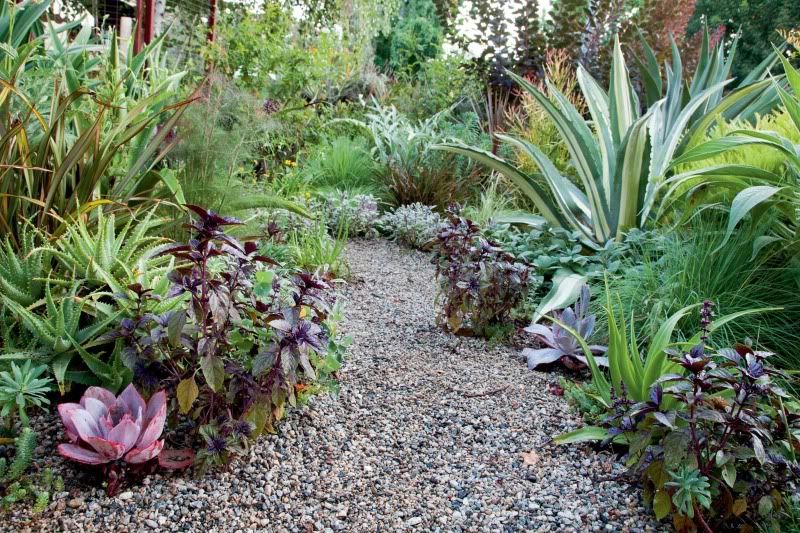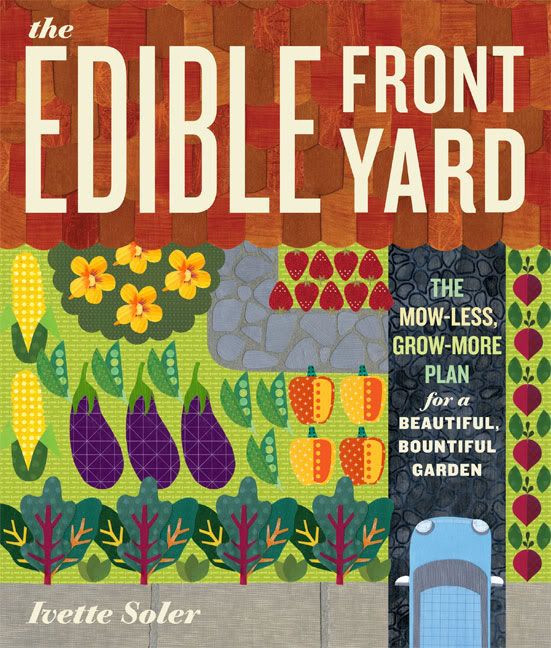I recently received a free copy of Ivette Soler's book The Edible Front Yard, and I wanted to share with you what a mind-blowing experience it was for me. Although I'm certainly not finished yet with the gardens in back, and work has just begun on the xeric gravel garden at the side of my house, I have been increasingly thinking about what to do with all the grass in my front yard. In my previous garden I grew tomatoes and cooking herbs in the best patch of sun I had, which was in the front yard. It was just a small bed near the house, with plenty of lawn still around it, buffering it from the street. None of my neighbors minded this landscaping faux pas, because I shared the tomatoes with them.
It never occurred to me how much more I could have done, and how much further I could have pushed the garden design envelope. The Edible Front Yard, with its subtitle "The Mow-Less, Grow-More Plan for a Beautiful, Bountiful Garden," is all about pushing the garden design envelope. The book begins with lists of plants like cardoon, artichoke, and rhubarb, that are not just edible, but also ornamental and structural, and a secondary list of what Ivette calls "helpers," such as agave, angelica, catmint, hops and juniper. The lists include advice on cultural requirements and how to use them (eat it, brew tea with it, make an alcoholic drink, etc.). The book goes on to discuss designs and design principles (structure, repetition, form, texture and color), how to assess your own front yard, and how to remove and reuse lawn, plants you already have, and hardscape materials you already have. The final chapters deal with building, working and harvesting (which, given that most edibles are annuals, includes the excellent advice to have substitute plants ready to incorporate into the spot where you've just removed spent plants).
The book is lushly illustrated with large, colorful photos. A favorite was the following, an illustration of the design principle of repetition.
 |
| Photo by Ann Summa, used courtesy of Timber Press |
It shows red basils and sages planted in multiples of threes and fives along a gravel path, providing not just edible, but ornamental value, supporting the color scheme of the other plants in the garden, and giving contrast to the spiky foliage of the grasses, agaves, aloes and Phormiums, and the wispy foliage of the fennel. Not only did the book give me inspiration for what to do with my front yard full of grass, but pictures like this one (there were more!) also gave me ideas to use in the gravel garden.
Every chapter either reinforced my thinking on certain subjects, or gave me ideas and made me think more. I like books that make me think.
******************
Timber Press gave me this book for free, but had no influence on my opinion of it. I've been doing a lot of reading about gardening lately. It's been very cold and rainy, and other than the obligatory walk once around the garden, taking note of where the weeds are so that first sunny day, I will know where to concentrate my energies, I've had no gardening to do -- oh wait, does buying plants count as gardening? I want to tell you about many of the other books I've read recently too, some from Timber Press and some not.
And you still have a couple of days to go to Timber Press and enter their edible gardens contest/giveaway, which I posted about here. To go to their website and enter, click here. The contest ends March 23.
